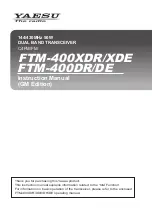
7
7. - (MINUS) BUTTON:
Press to move up or adjust selections within OSD menus. When not
in a menu, press to manually toggle between inputs (Receiver Mode only).
8. + (Plus) BUTTON:
Press to move up or adjust selections within OSD menus. When not in
a menu, press to manually toggle between inputs.
9. ENTER/INFO BUTTON:
When inside an OSD menu, press to confirm a selection or to go
deeper into a menu item. When not in a menu, press to activate the Information OSD.
6.2 Rear Panel
1. HDMI OUT PORT:
Connect to an HDMI TV, monitor or amplifier for digital video and
audio output.
2. HDMI IN PORT:
Connect to HDMI source equipment such as a media player, game
console or set-top box.
3. CAT5e/6A PORT:
Connect directly to a compatible transmitter/ receiver for Point-to-
Point extension, or to a 10 Gigabit Ethernet switch for distributed matrixing (requires
IP Master (EXT-PROCTRL) Controller or control software), with a single Cat.5e/6/7
cable for extension of all data signals.
Note: If the connected network switch supports the IEEE 802.3at- 2009 PoE (Power over
Ethernet) standard, this unit can optionally be powered directly via this Ethernet port.
4. AUDIO PORT:
A. Transmitter Mode:
Connect to the stereo analog output of a device such as a CD
player or PC.
B. Receiver Mode:
Connect to powered speakers or an amplifier for stereo analog
audio output.
Note: The signal is passed directly from the audio port on the transmitter to the audio port on
the receiver in Point-to-Point configurations.
5. IR OUT PORT:
Connect to an IR Blaster to broadcast IR signals from a connected
transmitter/receiver to devices within direct line-of- sight of the IR Blaster.
Note: Currently, only 38KHz IR signal extension is supported.








































